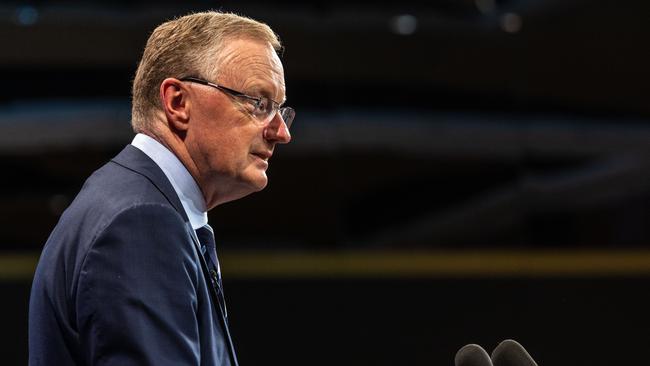RBA chief Philip Lowe has called out the failures that may force interest rates even higher


Why? RBA governor Philip Lowe has stressed this week that the world is dangerous, volatile and uncertain; he wants more time to assess the competing economic forces at home, especially the toll on families.
Still, rates may have to rise again because we are not equipped to handle the surges in demand that come from easy money, robust migration and dumb luck. Our capacity to produce has been static, reflecting cumulative national failures, through bouts of excess and slow-wave indolence.
If rates go high, don’t blame Lowe.
A pause means we are swimming against the tide. The world’s central banks are raising rates, even when conditions suggest their economies are doing a lot worse than our own. Australia’s unemployment rate is 3.5 per cent, while in February the new slimmed-down monthly reading of the consumer price index showed inflation easing to 6.8 per cent, down from its apparent peak of 8.4 per cent in December last year.
The RBA kept its cash rate target at 3.6 per cent this month, the board arguing the economy was rapidly slowing and it wanted to assess the fallout after 10 straight rises since May last year. Household spending is rising at half the rate of population growth.
Beyond our shores, the screws appear to be a lot tighter. The US federal funds rate range is 4.75 to 5 per cent but inflation is lower at 6 per cent; the Fed is expected to keep raising rates. New Zealand, Britain and Canada all have policy rates above the RBA’s target.
What’s so special about Australia that the RBA can afford a pit stop right now? At the National Press Club this week, Lowe offered three factors behind his confidence to wait and watch while peer central banks keep hiking.
First, economy-wide wages growth is 3.5 per cent, compared with around 5 per cent in North America and parts of Europe. You’d think the RBA would have factored in the coming chunky rise for minimum and award wage workers the ACTU is claiming and the Albanese government is supporting in the national wage case.
Second, Lowe argues the predominance of variable-rate mortgages means there is a “more powerful transmission mechanism” of monetary policy than in other countries.
Since last May, the average mortgage rate Australians pay has increased more quickly than in other countries. Required loan repayments will reach a new record high of almost 10 per cent of household disposable income by the end of next year.
Third, the RBA chief says it’s a deliberate policy to preserve our employment gains and nearly 50-year low jobless rate. Full employment is a magnificent base in a downturn. The RBA’s job is to keep inflation in a 2 to 3 per cent target band (something it hasn’t been good at lately). Lowe’s guesstimate is inflation won’t return to 3 per cent until the middle of 2025. He says there’s an argument the RBA could try to get back to target by the middle of next year, “but it would mean more job losses”.
Put those three factors together and Lowe says you can “establish a plausible case that interest rates in Australia don’t have to go up to the same level that we’ve seen around the world”.
“But there are a lot of uncertainties and that could change,” he says. There’s little room for error, and part of that is due to our woeful productivity performance and lack of economic dynamism and vitality, a mega-problem decades in the making. When demand outstrips supply, businesses put up their prices, and invariably the central bank steps in with its blunt interest-rate hammer to curb demand by squeezing household budgets. Again, that’s the RBA’s job. In the textbook, high prices are meant to stimulate more supply as well, as businesses invest in fresh capacity.
But our supply side hasn’t been expanding and the economy keeps hitting inflationary speed limits. That means, ultimately, lower living standards, as Lowe explained in his address. He says faster productivity growth delivers “a bigger pie, higher real wages, a lift in our collective wealth and a more prosperous economy”.
“It also means that, for a time, there is less upward pressure on inflation,” he says. “The fact that the supply side of our economy is growing more slowly than it once did carries the implication that demand also needs to grow more slowly if we are to avoid persistently higher inflation.”
Lowe, whose term expires in September, has been careful not to castigate governments, whose loose budgeting has made his demand management job more difficult at times, although the bank, too, has erred.
But he has never flagged in his advocacy for structural reforms that will benefit the community, “if Australia is viewed as a great place to expand, invest, innovate and employ people”.
Lowe has welcomed the Productivity Commission’s 1000-plus page blockbuster five-year review, published last month. “The good news in that report is that there are plenty of ideas on how we can lift our performance,” Lowe says. “The task now is to implement some of those ideas.”
Implicit, of course, is the less sunny side. The bad news is the political class in Canberra and the state capitals has shown it lacks the mettle and sales skills to make the policy trade-offs that may upset a few for the good of the many, and that ultimately help us get more buck for our precious capital and labour.
We are beginning to learn a lot more about why our productivity growth has stalled; looking more closely at the dividends from migration, how companies invest and the degree of competition in our markets reveals poor use of resources and a loss of dynamism.
Perhaps we’re not as special as we think.



The Reserve Bank’s decision to suspend its monetary assault on Australian borrowers may be only a temporary reprieve.